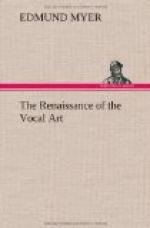In starting the first tone in all these exercises, feel the vibration in the face, on the forehead, and on the cheek-bones. If this is done without pushing, but by flexible action, a sympathetic vibration can be felt through the entire body.
A very effective and successful study of high placing and low resonance may be got through a consideration of the natural placing and resonance of the vowel sounds. As I have written so fully on the vowel sounds in my former works, I shall simply touch upon that important question here.
E as in reed is naturally the highest placed vowel in the English language. U or oo as in you or do is naturally the lowest in color. Sing E with the freedom of action as suggested, and think it high in the face. Make no effort to influence the form. The form of E is naturally very small. E will be found in this way to be free and bright, not hard and wiry. Sing oo in the same way. The form of oo is also very small. Oo should have a flute-like sound. It will be found that in E high resonance predominates. In oo low color. In studying the vowels the aim should be to equalize them by placing, reinforcing, and coloring them as nearly alike as possible. In this way they are equalized instead of differentiated.
Place E as suggested, and color it by the thought and influence of the low resonance of oo. Sing oo as suggested, and brighten it by the thought, influence, and high placing of E. In this way study all other vowels, influencing them by the high placing of E and the low resonance of oo. The high ring and brightness of the reed sounds of the voice, must be modified and influenced by the color and low resonance of the flute sounds. The flute sounds of the voice must be made more brilliant and free by the influence of the high placing and high resonance of the reed sounds. In this way we equalize all the vowels until, in a certain sense, they all have the same color and quality and sound, as though they belonged to one and the same voice. For a further study of high placing, use the second sound of O, or, as some writers classify the vowels, the second sound of U,—the sound of uh as heard in up. This is the highest, narrowest, and most elongated arch form in the English language; consequently it is, for many voices, the most favorable sound for the study of high placing.
All vowel sounds, like all tones of the voice, are reinforced sounds. The tendency of most singers is to sing the reed sounds too white and the flute sounds too dark. By properly distributing brilliancy and color we influence and modify all the vowels without losing their character or individuality.
PART THIRD.
AESTHETICS.
ARTICLE ONE.
THE FOURTH PRINCIPLE OF ARTISTIC SINGING.




